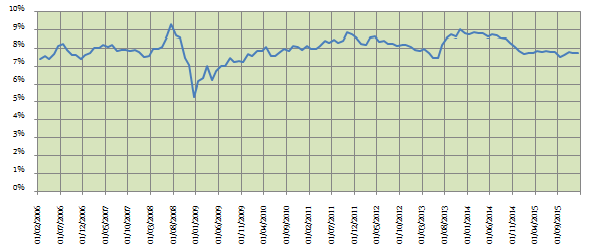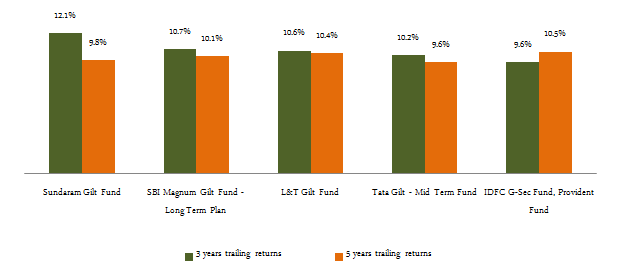Should you invest in Gilt Mutual Funds: Gilt Funds Demystified

Of the several mutual funds product categories available in the market, gilt funds are probably the least understood product category. Many retail investors stay away from gilt funds and many others have wrong strategies when investing in gilt mutual funds. Gilt funds invest in Government securities or bonds with varying maturities. Why are they called Gilt Funds? Historically, UK Government securities were issued on golden edged papers and hence are also known as gilt edged securities or simply gilts. In the Indian context, the usage of the term gilts is both a legacy of our colonial past and also a reference to the guarantee provided by the Sovereign or Union Government with regards to investments in these securities. There are several misconceptions with respect to Gilt Funds.
- Some retail investors mistakenly believe that Gilt Funds are risk free investments as they invest in Government securities. While the Government securities themselves are risk free with respect to interest and principal payments, the price of the securities fluctuates with changes in the yields or interest rates. Gilt funds are in fact the riskiest product class among all debt funds in the short term.
- On the other extreme, some retail investors believe that, Gilt Funds are as risky as equity funds. Gilt Funds are more volatile than other debt fund categories because the Net Asset Values (NAV) of Gilt Funds fluctuates with changes in yields or interest rates. If interest rates go up, the NAVs of gilt funds will decline and it is even possible to get negative returns in the short term. But comparing volatilities of gilt funds with that of equities is uninformed and obviously incorrect.
- Some investors and financial advisors believe that if the central bank, in our case the Reserve Bank of India (RBI), keeps interest rates unchanged, Gilt Funds will give steady returns. This is also incorrect, especially in the short term. While RBI interest rate actions have a big impact on the price of Government Securities or gilts, the price or yields of gilts will depend on the demand and supply of gilts, just like any other commodity. For example, if Government has to borrow more money to meet a higher fiscal deficit, it has to issue more Government Securities. If supply of a commodity is more than demand, then common sense logic tells us that, the price of the commodity will. In this case, if the fiscal deficit is higher, then the price of Government securities will fall. On the other hand, if say, the fiscal deficit or inflation is lower, the price of Gilts will increase. Therefore, even if the RBI does not take any rate action, the NAVs of Gilt funds will fluctuate depending on the demand and supply of Gilts. We will understand this in more details later.
How do Gilt Funds work
Before we go into gilt funds in more details, it is important to understand how debt funds in general generate returns. Debt funds employ two different kinds of investment strategy:-
Hold till Maturity:
This is also known as accrual strategy, by which the fund invests in certain types of fixed income securities (or bonds) and hold them till maturity of the bond, earning the interest offered by the bond over the maturity period.Duration Calls:
Using this strategy the fund manager, takes a view on the trajectory of interest rates. Bond prices are inversely related to interest rates. Why? Suppose you bought a 20 year bond with a coupon (interest) of 9% at face value ofर100 a year back. If interest rate goes down by 1% during the year then bond yields will decline and new bonds will be issued at a lower interest. Investors, who wish to earn a higher interest rate, will be ready to pay more thanर100 for your 20 year 9% coupon bond. Bond prices go up when interest rate falls and declines when interest rate goes up. Typically, the fund manager taking duration calls will invest in long term bonds because the longer the maturity, higher is the change in bond prices with change in interest rates.
Average maturities of government bonds in the portfolio of long term gilt funds are in the range of 15 to 30 years. The fund manager in long term gilt funds actively manage their portfolio and take duration calls with outlook on the interest rate. The returns of these funds are highly sensitive to interest rates movements. For example, if interest rate falls by 1% in a year, these funds can give 15 – 16% returns. If interest rates fall more, then the returns are higher. On the other hand, if interest rate rises then returns are lower.
To get a mathematical understanding of returns of a gilt fund, we should review two important concepts. It will get a little technical from here onwards, but please bear with us, because hopefully, armed with the conceptual knowledge you can become a much more informed debt fund investor. We will try to avoid mathematical equations, as much as possible, and try to understand the concept because as an investor the concept is important, the mathematics is less important.
Yield to Maturity:
Yield to maturity (YTM) is the return which a bond investor will get by holding the bond to maturity. For a debt fund, it is the return which the fund will get by holding the securities in its portfolio to maturity. For example if a debt fund’s portfolio has a YTM of 10% and a duration of 2 years, it means that, assuming no change to the portfolio, the fund will give 10% returns, as long as it holds the securities in its portfolio till they mature. i.e. for 2 years.Modified Duration:
Let us first understand what duration is. Duration is the measurement of how long, in years, it takes for the price of a bond to be repaid by its internal cash flows of the bond. Remember there are two kinds of cash flows in a bond, interest payments and principal payment. Some bonds pay the interest along with the principal on the maturity of bond. These are known as zero coupon bonds. Zero coupon bonds in India are issued at a discount to face value and you will get the face value on maturity. The duration of a zero coupon bond is the same as the maturity of the bond. However, there are some bonds which make interest payments also known as coupon payments to the investors at fixed interval, e.g. yearly and the principal is repaid on maturity. These bonds are known as vanilla bonds. Since a vanilla bond makes coupon payments on a regular basis to the investor, the investor recovers his investment well before the maturity of the bond. Let us assume you investedर100 in 20 year 10% coupon bond. If your bond pays 10% coupon, in other words, interest ofर10 every year, you will recover your investment in 10 years, much before the maturity of the bond. The duration of a vanilla bond is less than the maturity of the bond. However, you should understand that duration of the bond in the above example is not 10 years. The concept of duration factors in the time value of money. Simply put, the interest payment received next year is not equivalent to the interest received after 5 years, because the value of money goes down with time. This concept of duration in finance lingo is known as Macaulay duration. Let us now understand what modified duration is. Modified duration, is simply the price sensitivity of a bond to changes in yields or interest rates, in other words modified duration is the change in the price bond with a change of 1% in interest rate. So if the modified duration of a bond is 10 years and interest rates go down by 1%, then the bond price will increase by 10%. As simple as that. You must be wondering why we went into such a long explanation of duration, if modified duration is such a simple concept. The concept is simple, but the calculation of modified duration is not simple. The calculation of Modified Duration is very similar to Macaulay Duration. Even the numerical values are close. However, you should note that, while they are close, they are not the same. The calculations of Macaulay and Modified Durations are a little complicated, but as mutual fund you should worry about the calculations, because the fund fact sheets and various research websites have information on the Modified Duration of a fund. Simply remember, that if you expect interest rates to change a certain percentage, you can multiply the percentage change in interest rates with the modified duration to see how much the NAV will change.
How much return to expect from a Gilt Fund
If we combine the two concepts, Yield to Maturity (YTM) and Modified Duration, we can come up with a quantitative construct to calculative indicative returns based on certain assumptions. Suppose you invest र 100,000 in a Gilt Fund portfolio has a Yield to Maturity of 8% and Modified Duration of 10 years (as discussed earlier, you can find this information in fact sheet or various research websites). Your investment horizon is 3 years. You assume that in the next 3 years, interest rates or yields will decline by 2%. The expected return will be:-

On an annualized basis, in percentage terms, the return will be around 13%. However, please note that this is only a rough approximation of returns. You obviously need to deduct the expense ratio of the fund from the gross returns, to get the actual net returns. Further, the YTM and modified duration of fund portfolio may change over time. Finally, the actual trajectory of yields may be different from what was expected. For example, if the change in yields was only 1% instead of the expected 2%, returns will be lower (you can do the calculations yourself, based on the suggested equation). Now, what if interest rates rose by 1%, instead of falling by 2%? You would still get a positive return after 3 years. What if interest rates rose by 2%, instead of falling 2%? Again your gross returns, before expense ratio, will still be positive. So coming back to the perception that, that Gilt Funds are as risky as equity funds, if the Sensex or Nifty falls by 1 to 2%, the vast majority of equity funds will give negative returns. While in the short term both equity funds and gilt funds can be quite volatile, the risks involved in equity funds and gilt funds are very different. If you understand the concepts and risks, then Gilt Funds can be excellent investment options for you.
What are the different factors affecting Gilt Yields
By now, you should have realized that, the most important factor affecting the returns of your gilt fund investment is yields or interest rates. Though these two are Government bond yields and interest rates are often used interchangeably, it is important to understand the difference. What is interest rate? There can be many interest rates depending on the debt issuer. However, as far as the Reserve Bank of India is concerned, the repo rate is what they manage. When the RBI cuts interest rates by 50 basis points, it means that they have reduced the repo rate by 50 basis points. What is repo rate? Repo rate is the rate at which the RBI lends money to the banks. The repo rate is the foundation of the base interest rates of the lending institutions. Let us now understand the concept of Government Security or Gilt yields. The reference Gilt Yield is the 10 year Government Security Yield. As discussed earlier, yield is the annualized return which the investor will get by holding the bond till maturity. The yield and price of a bond are very closely related; in fact yield is a derivative of the price of a bond. We had discussed earlier that, the price or yield of a Government Security or Gilt depends on the demand and supply situation. Now, what does the demand and supply of Gilts depend on? The most important factor is the repo rate. But there are other related factors as well like:-
- Fiscal Deficit
- Inflation
- Foreign Exchange Rate
- Liquidity
Even if the repo rate is constant, if these factors get adverse then the Gilt yields will go up and the prices will come down. On the other hand, if these macro factors improve, then Gilt yields will go down and the prices will increase.
Outlook on Government Securities yields
The chart below shows the historical trend of the reference 10 year Government Security yield.

We can see from the chart above that, the 10 year Gilt yield has been on the decline from around 9% from 2014 onwards. There are several macro-economic reasons from the decline and there are enough reasons to believe that it will continue to decline further.
Lower Fiscal Deficit:
The NDA Government targeted a lower fiscal deficit of 3.9% of the GDP for FY 2016. As per the latest economic estimates, the Government is on track to meet its fiscal deficit target this financial year. The Government’s goal is to bring down fiscal deficit further by FY 2017 – 2018 to 3% of the GDP. Lower the fiscal deficit, lesser is the Government’s need to borrow money and hence we can see lower yields and higher Gilt prices in the future.Lower Inflation:
Inflation has a direct impact on Gilt yields. Lower inflation will encourage the RBI to further reduce repo rates to stimulate demand in the economy. Falling crude prices have lowered Wholesale Price Inflation considerably this year. Consumer Price Inflation has crept up over the last few months, which is a worry, but the RBI has targeted an inflation rate of 5.8% by January this year, which seems achievable. The RBI reduced interest rates by 125 basis points this year. The long term inflation target of 5% is also achievable, albeit there are certain risks of not meeting it. However, as per a Morgan Stanley report, this year bountiful monsoon is expected and this may have a very beneficial effect on inflation.Accommodative Monetary Policy Stance of RBI:
The RBI Governor, Raghuram Rajan as reiterated his accommodative monetary policy stance in most of his policy announcements this year. This means that the RBI is committed to reducing interest rates, to spur economic growth, provided inflation remains in check within the policy parameters. This augurs well for Gilt Fund investors in the long term, the short term volatility notwithstanding.Indian economy is structurally strong:
A number of global reports have suggested that the Indian economy is structurally strong, at a time when the global economy is going through a period of tumult. In fact, many reports from leading institutions have predicted that India will be a strong outperformer, in terms of GDP growth over the next few years. This will put lower pressure on fiscal deficit and consequently Gilt yields. The structural strength of the economy along with lower commodity prices globally, may prove to be very beneficial for Gilt Fund investors.
That the macros of the Indian economy are strengthening over the past few years is evidenced from the returns of Gilt Funds over the last 3 to 5 years. Top performing Gilt Funds like Sundaram Gilt Fund, SBI Magnum Gilt Fund, L&T Gilt Fund, Tata Gilt – Mid Term fund etc. have given excellent returns over the past three to five years.

Taxation of Gilt Funds
If units of debt mutual funds are redeemed within 36 months of purchase, then short term capital gains is calculated by subtracting the purchase cost from sales consideration. Short term capital gains is added to the income of the investor and taxed as per the income tax rate of the investor. If the units are redeemed after 36 months from the date of purchase then long term capital gains apply. Long term capital gains for debt mutual funds are calculated by subtracting the indexed cost of purchase from the sales consideration. The indexed cost of purchase is calculated by multiplying the actual cost of purchase with the ratio of cost of inflation index in the year of redemption and the year of purchase. Cost of inflation index table is published by the Reserve Bank of India and is available in the public domain. Long term capital gains for debt mutual funds are taxed at 20.6% (including education cess) after indexation. If held for a period of over three years gilt funds are much more tax efficient investments than many fixed income investment options.
Conclusion
Investors should have at least a 2 to 3 year investment horizon for investment horizon in gilt funds. The NAVs of gilt funds can be extremely volatile. If you have moderate to high risk tolerance level and are looking for capital appreciation, then you can invest in Gilt Funds. In this blog, we have discussed the risk return characteristics of gilt funds. Investors should consult with their financial advisors and discuss if gilt funds will be suitable for their investment objectives.
Queries
-
What is the benefit of mutual fund STP
Aug 29, 2019
-
How much to invest to meet target amount of Rs 2 Crores
Aug 26, 2019
-
Can I achieve my financial goals with my current mutual fund investments
Aug 24, 2019
-
Can you tell me return of various indices
Aug 19, 2019
-
What would be the post tax return on different investments
Aug 18, 2019
-
Which Principal Mutual Fund scheme will be suitable for my retirement corpus
Aug 16, 2019
-
What is the minimum holding period for availing NCD interest
Aug 4, 2019
Top Performing Mutual Funds
Recommended Reading
Fund News
-
Motilal Oswal Mutual Fund launches Motilal Oswal Diversified Equity Flexicap Passive Fund of Funds
Jan 2, 2026 by Advisorkhoj Team
-
Mr. Navneet Munot's 'Person of the Year 2025'
Dec 31, 2025 by HDFC Mutual Fund
-
Zerodha Mutual Fund launches Zerodha Nifty Short Duration G Sec Index Fund
Dec 26, 2025 by Advisorkhoj Team
-
Groww Mutual Fund launches Groww Nifty Chemicals ETF
Dec 26, 2025 by Advisorkhoj Team
-
DSP Mutual Fund launches DSP Nifty Next 50 ETF
Dec 19, 2025 by Advisorkhoj Team














